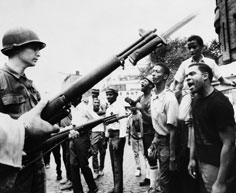‘Revolution ‘67’ details Newark’s urban rebellion
Lauren Carter
Writer and philosopher George Santayana once said, “Those who cannot learn from history are doomed to repeat it.” In the opening sequence of the new documentary “Revolution ’67,” a voice echoes that sentiment.
“If the lessons of Newark aren’t learned, your city can be next,” it says.
That mandate to examine the past in order to understand the present and shape the future is the motivation behind “Revolution ’67,” which details the “Black Urban Rebellion” in Newark, N.J., in 1967 and first aired on PBS’s “P.O.V.” series earlier this month.
“I’m a native daughter and resident of Newark, and for as long as I can remember, Newark has been stigmatized by the riots of 1967,” said director Marylou Tibaldo-Bongiorno in a statement. “The questions remain: What really happened, who’s to blame, and why hasn’t the city recovered? Are the problems Newark faced in the ’60s the same that plague it today? That’s why my husband and I made this film — to get those answers.”
The documentary began when Tibaldo-Bongiorno and her husband Jerome Bongiorno began researching Newark’s past for their short thesis film at New York University’s Graduate Film School.
Interviews with eyewitnesses of the riots of 1967 led to a number of surprises, among them the myth of the black sniper that was perpetuated by news outlets and served as a justification for police violence.
The fear of the “sniper,” already a sensitive term in a country embroiled in the Vietnam War, helped to shape public opinion that the bulk of the violence in the riots was incited by blacks. In fact, as the documentary notes, it was mostly caused by police and National Guardsmen, a claim verified by counts of bullets discharged: 13,000 by law enforcement, and less than 100 by civilians.
“I think one of the things we’ve learned from history is that the way it’s reported and the way it actually happened are sometimes not in neat convergence,” said historian Kenneth T. Jackson in the documentary. “And this is one of those cases.”
The Newark riots actually began as a result of a traffic infraction committed by cab driver John Smith, who was pulled over, beaten by police and later rumored to have died. Those false rumors spread throughout Newark’s black neighborhoods, spurring residents into protest and extensive looting that left buildings burned down and soon triggered responses by local and state police as well as the New Jersey National Guard.
The documentary also examines the long-term conditions underlying the riots, including racist lending practices, poor-quality housing referred to as “high-rise dungeons,” the effects of the Great Depression in 1929 on the highly industrialized city of Newark, city corruption that led to the imprisonment of prominent law enforcement officials, and the constant threat of police brutality.
“We were always fearful that our lives could be snatched away in a second by the police,” said former Mayor Sharpe James. “After all, they had the weapons, not us.”
The film uses interviews with activists, historians, journalists, former Newark government officials, policemen and National Guardsmen, as well as archival news footage to illustrate the climate of poverty and oppression that fueled the riots, which had similar counterparts in places around the country including Harlem, Detroit and the Watts neighborhood of Los Angeles.
Like many of those cities that experienced riots in the 1960s, Newark has never fully recovered.
As a result of the riots, 26 people died, hundreds were injured, 1,500 people were arrested and Newark was left with millions of dollars in property damage.
However, a grand jury investigation of the 22 homicides in the riot returned verdicts of “no cause for indictment” on all counts.
While the aftermath of the riots led to the proud display of afros, among other temporary surface changes, it had no real lasting effects, as activist Tom Hayden noted in the documentary.
“The damage was done,” Hayden said. “The troops were withdrawn, but there was no real sense that there was an intervention to finally solve any of the problems that had triggered this.”
Now, economically speaking, Newark is in worse shape than it was when the riots occurred: The poverty rate stands at 25 percent, compared to 18.4 percent in 1970, and few, if any, of the conditions that fueled the riots have been remedied.
As the filmmakers noted in a statement on the purpose of the film: “Forty years later, after numerous Newark officials have been indicted and/or imprisoned and the vital signs of the city are still poor, we recognize that Newark has not learned from its past. The greatest lesson of the 1960s is that the people must empower themselves in order for that change to occur.”
|
| Black residents of Newark, N.J., shout at National Guardsmen during the “Black Urban Rebellion” that took place in the city over the course of 1967. Director Marylou Tibaldo-Bongiorno’s new film, “Revolution ’67,” chronicles the riots and their aftermath, questioning whether Newark has recovered. (Photo courtesy of AMDOC.org) |
|







